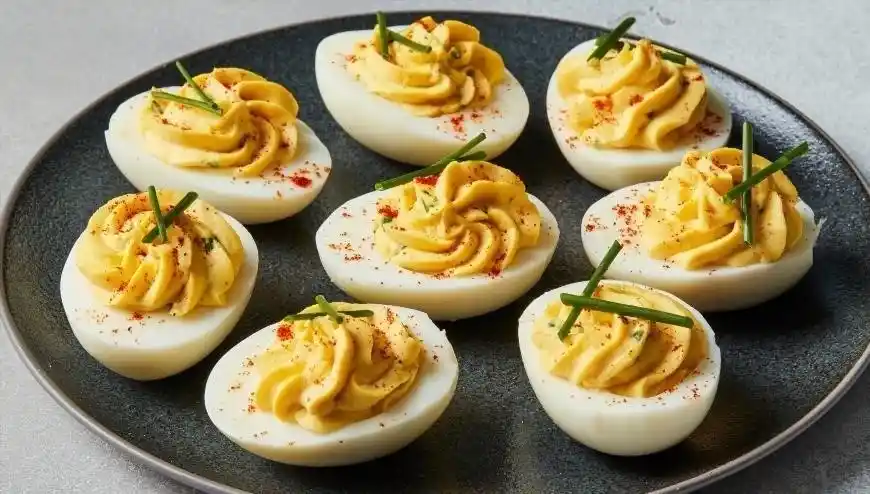Deviled eggs. Just the mention of them often brings to mind family gatherings, holiday dinners, and potluck parties. They’re simple to make but have a knack for elevating any meal, offering that perfect combination of creamy, tangy, and savory flavors. But how do you make the perfect deviled eggs? It’s not just about boiling eggs and slapping some mustard and mayo together (though, let’s be honest, that works too). Whether you’re a seasoned home cook or a beginner, this guide will walk you through everything you need to know to make deviled eggs that not only taste great but impress your guests too.
The Basic Recipe: Let’s Start Simple
Before diving into variations and tips, let’s go over the basic steps to make deviled eggs. This is the foundation upon which you can build creativity and flavors.
Ingredients:
- 6 large eggs (try to choose eggs that are at least a few days old—fresh eggs can be harder to peel)
- 1/4 cup mayonnaise (feel free to adjust based on your texture preference)
- 1 teaspoon Dijon mustard (regular mustard works too)
- 1 teaspoon white vinegar (this gives the filling a tangy kick)
- Salt and pepper to taste
- Paprika (optional, for garnish)
Directions:
- Boil the Eggs:
Place the eggs in a saucepan and cover them with cold water. Turn the heat to medium-high and bring the water to a gentle boil. Once the water starts to boil, reduce the heat to a simmer and cook the eggs for about 10-12 minutes. This ensures they are hard-boiled without being overcooked (which can lead to that unsightly green ring around the yolk). - Cool and Peel:
After cooking, transfer the eggs to an ice bath or run them under cold water to cool them down quickly. This stops the cooking process and makes them easier to peel. - Prepare the Filling:
Once peeled, cut the eggs in half lengthwise. Scoop out the yolks and place them in a bowl. Mash them with a fork until smooth. Add the mayonnaise, mustard, vinegar, salt, and pepper, mixing until everything is well combined. - Fill the Egg Whites:
Spoon the yolk mixture back into the egg whites. You can use a piping bag for a professional touch, or simply use a spoon. - Garnish:
Sprinkle with paprika for color and a bit of extra flavor. You can also add fresh herbs like chives or dill, or even a dash of hot sauce for a kick. - Serve and Enjoy!
Arrange your deviled eggs on a platter and serve chilled. They’re great for parties, picnics, or just a tasty snack.
Variations to Consider: Elevate Your Deviled Eggs
Once you’ve mastered the basic recipe, why not get a little adventurous? There are endless ways to elevate your deviled eggs and tailor them to your personal taste or the occasion.
- Bacon Deviled Eggs:
Crumbled bacon adds a savory, crispy element that takes your eggs from good to unforgettable. You can also sprinkle a little bacon on top for garnish. - Spicy Deviled Eggs:
Add a dash of hot sauce, sriracha, or cayenne pepper to give your eggs a kick. You can also mix in chopped jalapeños or chili powder for extra heat. - Avocado Deviled Eggs:
For a creamy twist, mash avocado into the yolk mixture. This adds richness and a unique flavor that pairs beautifully with the eggs. - Greek-Inspired Deviled Eggs:
Swap the mayo for Greek yogurt and add chopped Kalamata olives, feta cheese, and a bit of lemon juice for a Mediterranean flair. - Curried Deviled Eggs:
For those who love bold flavors, curry powder can give your deviled eggs an exotic, spicy twist. A little turmeric and cumin will do the trick.
Troubleshooting Common Issues: What Can Go Wrong?
While making deviled eggs is relatively straightforward, there are a few common pitfalls that even seasoned cooks sometimes encounter. Let’s address these so you can avoid them:
1. Eggshells That Won’t Peel:
This is one of the most frustrating issues. The best way to avoid this is by using eggs that are a few days old—newer eggs tend to have a stronger bond between the egg white and shell. After boiling, an ice bath or letting the eggs cool for 10 minutes before peeling can also help. If you’re still having trouble, try rolling the egg gently to loosen the shell before peeling.

2. Greenish Yolk:
If your yolks have a greenish tint around the edges, that means the eggs were overcooked. To prevent this, don’t boil your eggs for more than 12 minutes. After cooking, immediately cool them in an ice bath to stop further cooking.
3. Runny Filling:
If your deviled egg filling is too runny, it could be because you added too much mayo or mustard. Add a little more yolk or even a bit of breadcrumbs to thicken it up. You can also use a small amount of sour cream or cream cheese for a firmer, richer texture.
4. Bland Flavor:
If your deviled eggs lack flavor, you may need to adjust your seasoning. Don’t be shy with the salt and pepper, and try adding a little extra mustard or vinegar for tang. Also, experimenting with different add-ins (like fresh herbs or spices) can make a huge difference.
Health Considerations: Are Deviled Eggs Good for You?
While deviled eggs are delicious, they are often seen as a bit indulgent, and for good reason—they’re made with mayo and eggs, both of which are calorie-dense. Here’s a quick breakdown of their nutritional pros and cons:
- Pros:
- High in protein (thanks to the eggs)
- Rich in vitamins and minerals, including vitamin B12 and choline
- May be beneficial for those following low-carb or keto diets, as they are relatively low in carbs
- Cons:
- High in fat (due to the mayo and yolks)
- Can be high in cholesterol, which may be a concern for those with specific heart health concerns
- If you’re watching your calorie intake, a few deviled eggs can add up quickly
Tip: If you’re looking to lighten up your deviled eggs, try using Greek yogurt or avocado instead of mayo to reduce calories and fat. You could also swap the full-fat mayonnaise for a lighter version or use a smaller amount.
Opinions from Real People
Here are some insights and opinions from different people around the world on deviled eggs:
- Maria (65, USA):
“Deviled eggs are a staple in my house, especially around holidays. My grandkids love them. I’ve been making them for years, but I’ve started experimenting with adding fresh dill and lemon zest. It adds a fresh twist, and the kids love it!” - Chad (40, UK):
“I’m not usually one for mayonnaise, but when it comes to deviled eggs, I make an exception. I love adding a little bit of curry powder. It gives them a zing that makes them perfect for summer BBQs.” - Keiko (55, Japan):
“In Japan, deviled eggs are not as common, but I first tried them when I visited America. I was blown away by how simple they were, yet so delicious. I tried making them at home with a little wasabi in the filling. It was a hit!” - Amina (29, Nigeria):
“Deviled eggs are a nice treat, but I find they’re a bit heavy for my everyday diet. I usually make them for parties, and I like to add a touch of spice, maybe some ground chili, to give them a local twist.” - Javier (50, Spain):
“I’ve seen deviled eggs at a few international gatherings here in Spain, but we don’t make them much ourselves. I think they’re great for appetizers, but I like to add a drizzle of olive oil and a sprinkle of paprika for a Mediterranean flair.”
Conclusion: Deviled Eggs for Every Occasion
There you have it—a complete guide to making deviled eggs. Whether you prefer them classic, spicy, or with a twist, this dish is versatile, delicious, and perfect for almost any occasion. With a little know-how, you can master this timeless recipe and even put your own spin on it. So, next time you’re in need of a crowd-pleasing appetizer, consider deviled eggs—they’re not only tasty, but they’ll also bring a bit of nostalgia to your gathering.
Happy cooking!









